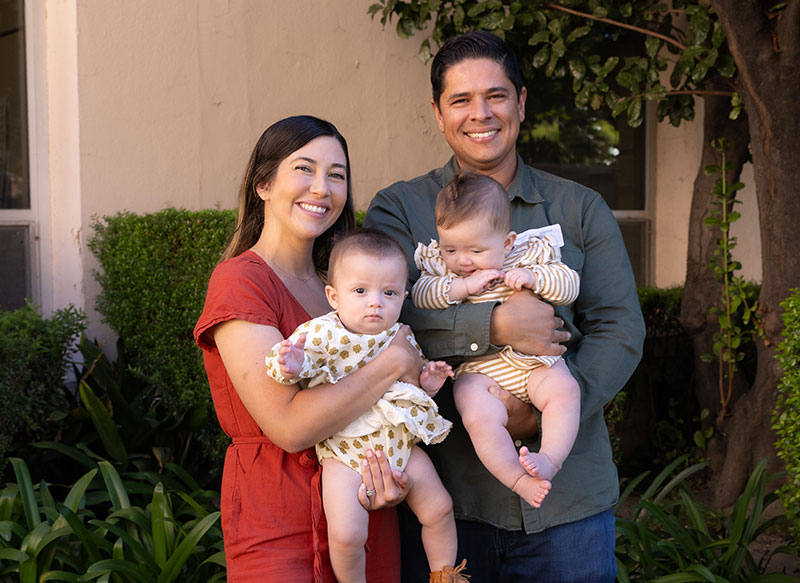After two healthy pregnancies with her boys Luca and Joaquin, and a stillbirth with her angel baby Soleil, Celina Lemon experienced secondary infertility. So, when she and her husband, Juan, found out that they were pregnant with two baby girls, they were overjoyed. Over the first 31 weeks, Celina’s pregnancy went fairly smooth, as she anxiously waited for her due date so she could finally meet her baby girls. However, on March 8, 2023, Celina woke up feeling dizzy with a severe headache and knew she had to go to the hospital.
Juan immediately called 911. By the time the ambulance arrived, Celina was hypertensive and losing consciousness. She was rushed to our Nan and Howard Schow Emergency & Trauma Center. “I was terrified for her and our babies,” recalls Juan. “As I rode in the front of the ambulance, I couldn’t see her and was scared the whole way to the ER.” Within minutes of her arrival here, Celina was in cardiac arrest — endangering both her and her unborn children.
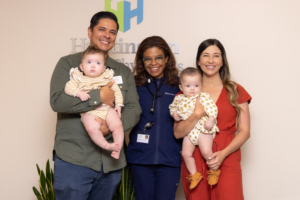
Our team of expert physicians immediately mobilized. With three lives hanging in the balance, Huntington Health-affiliated emergency medicine physician Maria Ximena Vargas Jaramillo, MD, called on more than 25 caregivers across three departments. It was decided that Melissa Grier, MD, a Huntington Health-affiliated OB-GYN (pictured left), needed to perform a cesarean section in the emergency department, and fast. “It felt like the whole department stopped to take care of this family,” says Dr. Grier. We didn’t know what was going on yet, but knew we had to get the babies out right away.”
Dr. Grier delivered twin girls Camila and Ciena within three minutes — before they would start to lose oxygen. At the same time, Jenny Van Slyke, RN, BSN, pre-hospital program manager, performed chest compressions on Celina. Because the babies were premature, they were quickly moved to our neonatal intensive care unit (NICU) for additional care. Meanwhile, Celina’s condition was deteriorating.
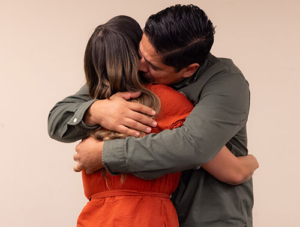
An arteriovenous malformation (AVM)* had ruptured, causing bleeding in her brain. Celina was rushed to the operating room to drain the blood and relieve the pressure on her skull. The procedure performed by Huntington Health-affiliated neurosurgeon Lance Gravely, MD, was successful, but Celina remained unconscious. “The doctors didn’t know if Celina would wake up again,” says Juan. “They were preparing us for the worst. I couldn’t believe what was happening and was completely heartbroken for many reasons. I was thinking about our boys, how Celina might never have a chance to meet her girls, and how I wasn’t ready to lose the love of my life.”
A couple of hours after her first procedure, Huntington Health-affiliated interventional radiologist Angelos Konstas, MD, performed a successful cerebral angiogram to stop the bleeding. Daryl Banta, MD, medical director of pulmonology and critical care, closely monitored Celina in our critical care unit (CCU). Additionally, CCU nurses attended to Celina, and our social workers offered support to Juan, who now had a wife in the CCU and newborn babies in the NICU.
Miraculously, the next morning, Celina woke up, marking the start of a long recovery. “Nobody could believe that Celina was conscious that quickly,” Juan recalls. “Everyone was crying with happiness.” She spent more than three weeks in our CCU, before moving to our acute inpatient rehabilitation department. There, she slowly relearned basic tasks like how to talk and eat. Her physical and occupational therapists also helped her relearn skills she would need as a mother of newborns, such as changing a diaper and carrying a baby. “Every step of the way,” says Juan, “we felt like we were treated like family.”
Camila and Ciena spent five weeks in the NICU before going home to be with their dad and two older brothers. Two weeks later, Celina went home, too, and transitioned to an intensive in-home therapy program and then outpatient rehabilitation to continue her recovery.
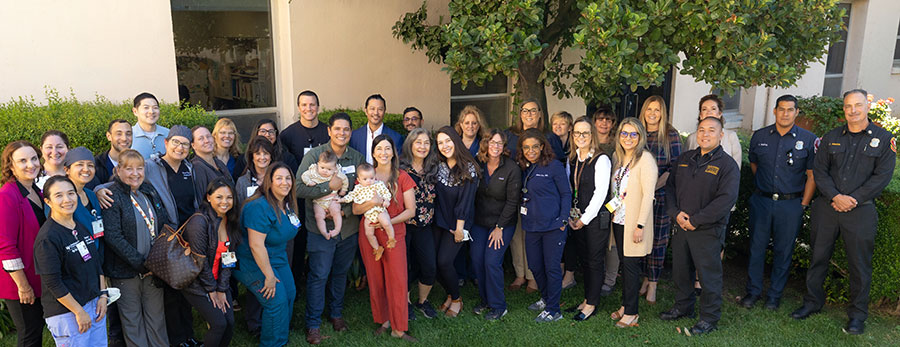
Today, the twins are 10 months old and as healthy as can be, and their mother, who has made great progress, continues to heal. Jenny Van Slyke recently arranged a reunion at the hospital for the family and the caregivers involved in their care (pictured above). “I can’t begin to express my gratitude for the team who saved my life and my girls,” says Celina. “I know I still have many deficits and a long road ahead, but I continue to push myself and do occupational, physical and speech therapy to try to have the best recovery possible for my little ones.”
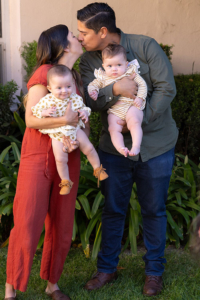
This new year, Celina and Juan are focusing on appreciating their time together and savoring the little things. “This experience has reminded us of the importance of not taking time with each other for granted,” says Celina. “Life can change in an instant.”
They also hope Celina’s story can help raise awareness about AVMs to help save the lives of others. “We had no idea that I had an AVM all my life until it ruptured,” says Celina. “I’m so glad I listened to my intuition and told my husband to get me to Huntington Hospital right away. I hope others, including other pregnant women, can learn from my story in case they ever feel something similar. Getting me to a great hospital so quickly is what ultimately saved me and my daughters.”
Click to learn more about our lifesaving emergency & trauma and NICU care.
*An arteriovenous malformation (AVM) is an abnormal tangle of blood vessels that causes problems with the connections between your arteries and veins. AVMs most often occur in the spinal cord and in the brain, but can develop elsewhere in the body.
Normally, arteries carry oxygen-rich blood away from the heart to the body’s cells, organs, and tissues and veins return blood with less oxygen to the lungs and heart. But in an AVM, the absence of capillaries — small blood vessels that connect arteries to veins and deliver oxygen to cells — allows blood to pass directly from arteries to veins, missing tissue that needs oxygenated blood. This can lead to tissue damage and the death of nerve cells and other cells. Over time, some AVMs get progressively larger as the amount of blood flow increases. (Source: National Institute of Neurological Disorders and Stroke)
If you are grateful for the care you received at our hospital and would like to share your experience, please send us your story.
 English
English Espanol
Espanol 简体中文
简体中文 Tagalog
Tagalog հայերեն
հայերեն 한국인
한국인 Tiếng Việt
Tiếng Việt فارسی
فارسی русский
русский 日本
日本 عربي
عربي